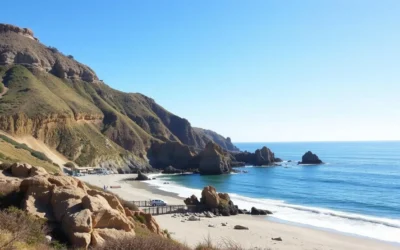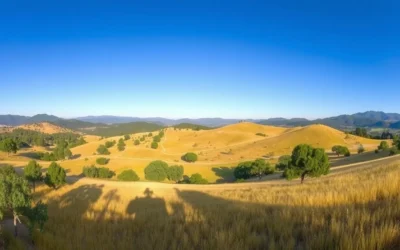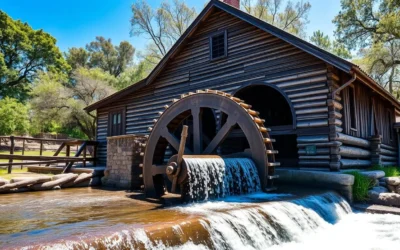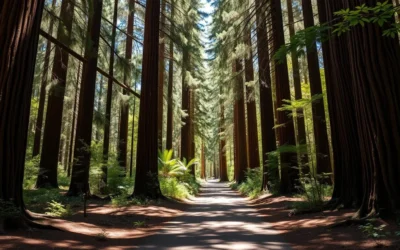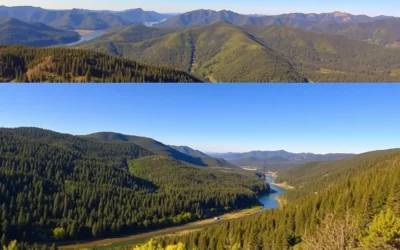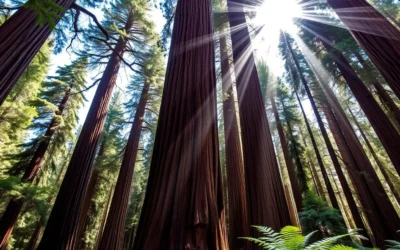Imagine cruising down a legendary highway, surrounded by the diverse landscapes of California, from the Mojave Desert to the sun-kissed Pacific coast. You’re not just driving; you’re on a journey through America’s rich history and nostalgia.
Over 4 million people travel along the Mother Road every year, drawn by its promise of adventure, freedom, and the quintessential American dream. As you embark on this approximately 350-mile stretch from Needles to Santa Monica, you’ll discover a treasure trove of quirky roadside stops, historic landmarks, and breathtaking natural beauty.
From ghost towns to vibrant cities, this iconic road trip is a must-experience for any traveler. Get ready to explore the attractions that make California’s portion of this legendary highway so special.
The History and Legacy of Route 66 in California
Route 66’s journey began in 1926, bridging Chicago and Los Angeles over 2,400 miles of diverse landscapes. This iconic highway was more than just a road; it was a pathway to new opportunities and a symbol of freedom.
![]()
From Chicago to Santa Monica: The Mother Road’s Story
The establishment of Route 66 in 1926 marked a significant milestone in American transportation history. Spanning eight states, including California, this highway connected the Midwest to the West Coast, facilitating travel and commerce. As you drive along this historic route, you’ll discover how it evolved from a practical transportation artery to a cultural icon, celebrated in literature, music, and film.
| Year | Event | Significance |
|---|---|---|
| 1926 | Route 66 commissioned | Connected Chicago to Los Angeles |
| 1930s | Dust Bowl migration | Route 66 became a path to hope |
| 1950s-60s | Cultural icon status | Featured in media and arts |
California’s Unique Role in Route 66 Culture
California represented the promised land at the western terminus of Route 66, symbolizing hope and new beginnings for countless migrants. The state’s diverse landscapes, from desert terrains to urban centers and the Pacific coastline, offer a unique experience for travelers. As the final leg of the journey, Los Angeles and later Santa Monica became the coveted end points, embodying the spirit of adventure and freedom that Route 66 embodied.
Planning Your California Route 66 Road Trip
To make the most of your California Route 66 adventure, careful planning is essential. This iconic road trip spans approximately 350 miles from the Arizona-California border to Santa Monica, offering a diverse range of experiences along the way.
Best Seasons for Desert and Coastal Driving
The best time to drive Route 66 through California is between October and April. During these months, the desert temperatures are comfortable for exploration, and the coastal areas offer pleasant conditions with fewer crowds. This makes it an ideal period for a road trip, allowing you to enjoy the scenic views and attractions without the harsh desert heat or crowded tourist spots.
Recommended Itinerary: 4-Day Journey
For a memorable experience, consider a 4-day journey covering the historic route. Strategic overnight stops in Barstow, San Bernardino, and Pasadena can maximize your sightseeing opportunities. Allocate your daily driving distances thoughtfully, with shorter mileage through urban areas where attractions are concentrated, and longer stretches through desert portions where stops are more spread out.

Vehicle Considerations and Road Trip Essentials
When preparing for your trip, consider your vehicle choice carefully. While a standard sedan works fine for the paved sections, a high-clearance vehicle might be preferable if you plan to explore desert detours or off-the-beaten-path attractions. Pack essential road trip supplies, including plenty of water, snacks, sun protection, a first aid kit, and a paper map or guidebook, as cell service can be spotty in remote desert sections of the historic route.
By planning your California Route 66 road trip during the optimal seasons and being well-prepared, you can ensure a smooth and enjoyable journey along this iconic historic route. Whether you’re driving east west or following the original alignment, the adventure will be a memorable part of your travel story.
Navigating Historic Route 66 in California Today
With about 85% of the original Route 66 still drivable in California, planning your route is the first step to a memorable trip. Although the road has been decommissioned, much of it remains intact, hidden under various modern highway designations and local street names.
Finding the Original Alignments and Historic Signs
To experience the authentic charm of Route 66, you’ll need to identify the historic alignments. Look for “Historic Route 66” signs, distinctive roadside architecture, and original infrastructure that still dots the 350-mile California stretch. These markers will help you stay on the genuine Mother Road alignment.

Best Maps, Apps, and Guidebooks for Route 66
Preparation is key to navigating Route 66. Use specialized Route 66 guidebooks, dedicated apps like Route 66 Navigation, and detailed paper maps as a backup for areas with poor cell reception. Downloading maps and directions before your trip is crucial, especially in remote desert sections between Needles and Barstow.
| Navigation Tool | Description | Usefulness |
|---|---|---|
| Route 66 Guidebooks | Detailed guides with historical context | High |
| Route 66 Navigation App | Dedicated app for route navigation | High |
| Paper Maps | Physical maps for backup in low-reception areas | Medium |
By capturing photos of the iconic brown Historic Route 66 signs and vintage motel signs, you’ll be able to confirm you’re on the right path and create lasting memories of your trip.
The Eastern Gateway: Needles to Amboy
Your California Route 66 journey starts in Needles, a charming town named after the distinctive pinnacles in the nearby Mohave Mountains. As you begin your adventure, explore the historic El Garces Hotel and snap photos of the classic Route 66 Motel, setting the stage for a nostalgic trip along this iconic road.
Needles: First Stop in California
Needles is more than just a starting point; it’s a gateway to the rich history and natural beauty of the Mojave Desert. The town’s name is derived from the sharp peaks of the Mohave Mountains, a landmark that has fascinated travelers for decades. Be sure to visit the historic sites and take in the unique landscape that defines this part of Route 66.
Ghost Towns of Goffs, Essex, and Danby
As you journey west on Route 66, you’ll encounter the fascinating ghost towns of Goffs, Essex, and Danby. These once-thriving stops along the railroad and highway now stand as testaments to the past, with abandoned buildings, old general stores, and vintage service stations telling the story of a bygone era. Exploring these ghost towns offers a unique glimpse into the history of the Mother Road.
The Iconic Roy’s Motel and Café in Amboy
No stop on this segment of Route 66 is complete without visiting the iconic Roy’s Motel and Café in Amboy. This quintessential landmark, with its distinctive Googie architecture and towering neon sign, has welcomed travelers since 1938. As the only gas station, restaurant, and lodging for miles around, Roy’s is a must-see attraction that embodies the spirit of Route 66.
| Attraction | Location | Description |
|---|---|---|
| El Garces Hotel | Needles | Historic hotel showcasing the charm of early 20th-century architecture |
| Roy’s Motel and Café | Amboy | Iconic motel and café with Googie architecture and a towering neon sign |
| Ghost Towns | Goffs, Essex, Danby | Abandoned towns along Route 66, offering a glimpse into the past |
As you drive along the original alignment of Route 66, now known as the National Trails Highway, the stark beauty of the eastern California desert landscape unfolds before you. Miles of open road invite you to experience the genuine taste of the historic Mother Road. Understanding the boom and bust cycle of the small towns along Route 66 adds depth to your journey, as you witness the remnants of mid-century Americana that still linger.
Desert Wonders: Amboy to Barstow
The stretch from Amboy to Barstow on Route 66 is filled with fascinating desert wonders waiting to be explored. As you journey through this section of the Mother Road, you’ll encounter a mix of natural landmarks, ghost towns, and nostalgic roadside attractions that capture the essence of California’s desert landscape.
Amboy Crater National Natural Landmark
Just a little bit further along the National Trails Highway, take the road to the Amboy Crater, a National Natural Landmark. This 250-foot high extinct cinder cone offers a 3-mile trail to the rim, providing spectacular desert views. You can hike the trail or simply admire its symmetrical beauty from the viewing area. The crater is a must-see attraction, standing as a testament to the region’s volcanic history.

Ludlow and Newberry Springs Attractions
As you continue on Route 66, you’ll come across Ludlow, a once-thriving mining town that saw a brief revival during the route’s heyday. Explore the remnants of the Murphy Bros. General Store and old service stations. You can enjoy a meal at the Ludlow Cafe, adding a touch of modern comfort to your historical journey. Nearby, Newberry Springs is home to the famous Bagdad Cafe, a roadside attraction made famous by a 1987 German film. This cafe offers classic American diner fare along with movie memorabilia, making it a unique stop on your route.
Calico Ghost Town Side Trip
A worthwhile detour from Route 66 is the Calico Ghost Town, a well-preserved silver mining town turned regional park. Here, you can explore restored 1880s buildings, take mine tours, and try your hand at gold panning. These activities bring the Old West back to life, providing a rich historical experience. Calico is a great place to stretch your legs and enjoy the desert scenery.
| Attraction | Location | Description |
|---|---|---|
| Amboy Crater | Amboy | 250-foot high extinct cinder cone with 3-mile hiking trail |
| Ludlow | Ludlow | Remnants of a mining town with old service stations and a cafe |
| Bagdad Cafe | Newberry Springs | Famous roadside cafe known for its appearance in a 1987 film |
| Calico Ghost Town | Calico | Preserved silver mining town with restored buildings and mine tours |
As you travel from Amboy to Barstow, the desert landscape offers a unique blend of natural beauty and historical significance. Take your time to explore these attractions, and enjoy the journey along one of America’s most iconic roads.
Barstow to Victorville: Historic Route 66 Highlights
As you drive along Route 66 from Barstow to Victorville, you’ll be treated to a visual feast of retro roadside attractions and historic museums. This stretch of the Mother Road is home to a plethora of nostalgic landmarks that showcase the rich history and cultural significance of Route 66.
The center of Barstow is home to a host of old Route 66 motels, some of which are still in operation today. You can explore Barstow’s rich Route 66 heritage at the Mother Road Museum, housed in the historic Harvey House Railroad Depot. The museum features fascinating artifacts, vintage photographs, and memorabilia that document the highway’s golden era.
Route66 Mother Road Museum in Barstow
The Mother Road Museum is a must-visit attraction in Barstow, offering a glimpse into the history of Route 66. With its extensive collection of artifacts and exhibits, you’ll gain a deeper understanding of the highway’s significance and its impact on the communities it touched.
Elmer’s Bottle Tree Ranch in Oro Grande
Just outside Barstow, you’ll find the quirky and artistic Elmer’s Bottle Tree Ranch in Oro Grande. This unique attraction features a forest of metal “trees” adorned with colorful glass bottles that catch the desert sunlight, creating one of the most photographed scenes along Route 66 today.

California Route66 Museum in Victorville
As you continue your journey to Victorville, be sure to visit the California Route66 Museum. This comprehensive museum showcases an impressive collection of vintage automobiles, including a 1917 Model T Ford, along with interactive exhibits that bring the history of the Mother Road to life.
| Attraction | Location | Description |
|---|---|---|
| Mother Road Museum | Barstow | Historic museum showcasing Route 66 artifacts and memorabilia |
| Elmer’s Bottle Tree Ranch | Oro Grande | Unique attraction featuring metal trees adorned with glass bottles |
| California Route66 Museum | Victorville | Comprehensive museum with vintage automobiles and interactive exhibits |
In addition to these main attractions, you can also admire the collection of classic neon signs and historic motels along Barstow’s Main Street, including the El Rancho Motel with its stunning vintage signage. Be sure to discover lesser-known roadside attractions between Barstow and Victorville, such as the Polly Gas Station sign and Burden’s Store and Post Office, built in 1926.
San Bernardino Area Must-See Stops

With its historic motels, museums, and eateries, San Bernardino is a must-visit destination for any Route 66 enthusiast. As you explore this vibrant city, you’ll discover a unique blend of nostalgia and adventure that defines the spirit of America’s iconic highway.
Wigwam Motel: Sleep in a Teepee
Experience a truly unique overnight stay at the Wigwam Motel in San Bernardino, where you can sleep in one of 19 concrete teepees built in the 1950s. Modern amenities like air conditioning and WiFi complement the vintage Route 66 charm, making it a memorable stop on your journey.
The Original McDonald’s Museum
Visit the Original McDonald’s Museum located on the site of the very first McDonald’s restaurant from 1948. Here, brothers Richard and Maurice McDonald revolutionized fast food with their “Speedee Service System” before Ray Kroc entered the picture, marking a significant moment in American culinary history.
Historic Mitla Café and Its Legacy
Savor authentic Mexican cuisine at the Historic Mitla Café, a family-owned establishment operating since 1937. This iconic eatery not only served generations of travelers but also reportedly inspired Glen Bell to create Taco Bell after studying their popular hard-shell tacos, leaving a lasting legacy in the world of fast food.
These San Bernardino landmarks represent important chapters in American cultural history, from roadside architecture innovations to the birth of fast food that would change dining habits worldwide. Today, they continue to operate, offering visitors an authentic taste of mid-century Route 66 culture in a region that has otherwise seen significant development and change.
U.S. Route 66, California: Driving – Attractions, Landmarks, Fun
As you embark on your California Route 66 adventure, you’ll discover a treasure trove of roadside attractions and landmarks that define the Mother Road’s spirit. This iconic route is more than just a road; it’s a journey through the history and culture of America, with California’s stretch being particularly rich in nostalgic charm.
Roadside Architecture and Vintage Neon Signs
The roadside architecture along California’s Route 66 is a visual feast, with Googie-style designs and Spanish Colonial Revival buildings standing out. These styles not only reflect the architectural trends of the mid-20th century but also add to the route’s unique character. As night falls, the vintage neon signs along the route illuminate the darkness, offering a spectacular display of color and light that’s perfect for capturing memorable photos on your road trip.
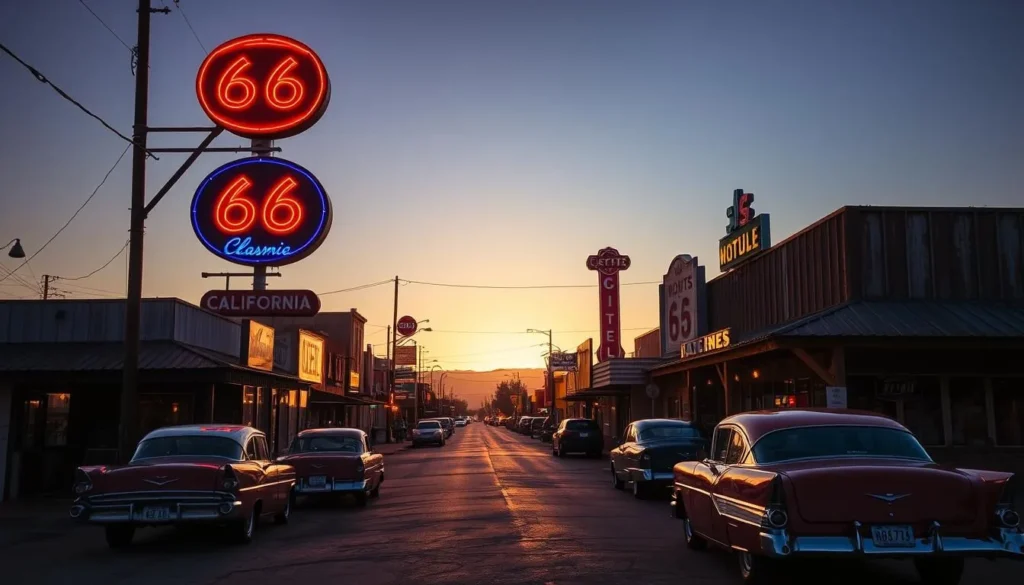
Classic Diners and Service Stations
Classic diners and restored service stations are integral to the Route 66 experience, providing travelers with a taste of 1950s ambiance and American comfort food. These establishments, such as Emma Jean’s Holland Burger Café, have become landmarks in their own right, attracting visitors from all over the world. They offer more than just a meal or a fill-up; they provide a connection to the past, a nostalgic reminder of the golden age of road tripping.
| Landmark | Location | Description |
|---|---|---|
| Roy’s Motel and Café | Amboy | Iconic motel and café with vintage signage |
| Santa Monica Pier | Santa Monica | Official end of Route 66, a popular beachside amusement park |
| Cabazon Dinosaurs | Cabazon | Giant dinosaur statues, a kitschy roadside attraction |
Photo-Worthy Moments Along the Mother Road
Capturing the essence of your Route 66 journey requires timing and a keen eye for the photo-worthy moments that abound along the route. From the sunrise over the Mojave Desert to the sunset behind vintage neon signs, there are countless opportunities to snap memorable photos. The classic roadside attractions, with their kitschy charm and nostalgic appeal, make for compelling subjects, too.
As you plan your road trip itinerary, consider the best times for photography and sightseeing to make the most of your journey along the Mother Road.
Rancho Cucamonga to Pasadena Stretch
The Rancho Cucamonga to Pasadena stretch of Route 66 is a treasure trove of history, nostalgia, and entertainment. As you drive along this 30-mile segment, you’ll witness the transition from the inland communities of San Bernardino County to the more urbanized Los Angeles region.
![]()
Historic Sycamore Inn and Cucamonga Service Station
One of the must-visit attractions in this stretch is the historic Sycamore Inn in Rancho Cucamonga. This establishment has been around since the mid-1800s and became a Route 66 favorite in 1939. It’s still beloved for its old-school prime rib and minestrone soup, and now also offers a wine bar. Nearby, the restored Cucamonga Service Station, built in 1915, now functions as a mini-museum showcasing historic photographs and memorabilia from the early days of automobile travel along this important highway.
Pasadena’s Colorado Boulevard and Tournament of Roses Connection
As you continue along Foothill Boulevard, the historic alignment of Route 66, through the communities of Upland, Claremont, and La Verne, you’ll notice vintage signs and historic buildings lining the way. Eventually, you’ll reach Pasadena’s Colorado Boulevard, a significant stretch of the original Route 66 that gained additional fame as the route of the annual Tournament of Roses Parade. This connection links the highway’s history with one of America’s most beloved New Year’s traditions, making it a fascinating road to explore.
Covering around 30 miles, this segment of Route 66 offers a captivating study in the changing landscapes along the Mother Road. You’ll pass through various communities, each with its unique character and charm, making the journey from Rancho Cucamonga to Pasadena a memorable experience.
Los Angeles County’s Route 66 Treasures
You’ll uncover a wealth of Route 66 treasures as you travel through Los Angeles County, where history and glamour entwine. This section will guide you through some of the most significant attractions along this iconic stretch of the Mother Road.
Clifton’s Republic: A Historic Downtown Landmark
Clifton’s Republic, which opened in 1932 near the original western terminus of Route 66, is a must-visit landmark. This historic restaurant and nightclub was known for its progressive policies during the Depression and its eclectic forest-themed architecture. With its unique blend of quirky decor, including a tiki bar and a giant tree paying tribute to Muir Woods, Clifton’s is a testament to the creativity and inclusivity that defined Route 66’s heyday.
Route 66 Through Hollywood and Beverly Hills
As Route 66 winds its way through Los Angeles County, it passes along famous thoroughfares like Sunset Boulevard and Santa Monica Boulevard, traversing glamorous neighborhoods such as Hollywood and Beverly Hills. Here, you’ll find iconic attractions like the Hollywood Walk of Fame and the Chinese Theatre, landmarks that have been immortalized in film and television. The neon signs and Art Deco architecture that characterize many buildings along this stretch of Route 66 are a nod to the region’s golden age of design.
As you explore this urban stretch of Route 66, you’ll have the opportunity to shop at unique establishments, from vintage clothing stores and record shops to specialty museums and eateries that maintain connections to the highway’s storied past. Whether you’re a history buff, a fan of vintage architecture, or simply looking for a memorable experience, Los Angeles County’s Route 66 treasures have something to offer.
Santa Monica: The End of the Trail
Your epic journey on Route 66 comes to a thrilling conclusion at the Santa Monica Pier, where the historic highway meets the Pacific Ocean. The excitement is palpable as you arrive at this iconic landmark, marking the end of your cross-country adventure.

The Official End of Route 66 Sign and Pier
The Santa Monica Pier is more than just a picturesque ending to your journey; it’s a historic landmark that has welcomed travelers since 1936. The “End of the Trail” sign, installed in 2009, stands proudly near the Pacific Park amusement rides, making for a perfect photo opportunity.
As you explore the pier, you’ll discover its landmark entrance arch, the vintage carousel housed in the Looff Hippodrome, and panoramic ocean views that will leave you in awe. The pier’s rich history and vibrant atmosphere make it a must-visit destination.
Celebrating Your Route 66 Completion
Celebrate the completion of your Route 66 journey by immersing yourself in the city’s vibrant atmosphere. Enjoy the beautiful beaches, savor the local cuisine, and relish the satisfaction of having traveled the same route as millions of adventurers before you.
Take a moment to reflect on the incredible experiences you’ve had along the way, from the quirky roadside attractions to the historic landmarks. Your Route 66 adventure may be over, but the memories you’ve created will last a lifetime.
Where to Stay: Historic and Modern Lodging Options

From vintage motels to modern hotels, California’s Route 66 offers a diverse range of lodging options to suit every traveler’s needs. Whether you’re looking to immerse yourself in the nostalgic charm of the Mother Road or enjoy contemporary comforts, there’s something for everyone.
Iconic Route 66 Motels Worth Experiencing
Experience authentic Route 66 nostalgia by staying at historic motels like the Wigwam Motel in San Bernardino, where concrete teepees offer a unique overnight adventure combined with modern amenities including WiFi and a refreshing swimming pool.
Other iconic vintage accommodations along California’s Route 66 include the Route 66 Motel in Needles with its classic neon sign and the El Rancho Motel in Barstow that preserves the mid-century roadside aesthetic. Beloved since 1939, the Blue Swallow Motel is well worth an overnight stay.
Comfortable Modern Accommodations Along the Route
Enjoy modern comfort without sacrificing location by selecting contemporary hotels strategically positioned along the historic route, offering amenities like indoor and outdoor swimming pools, fitness centers, and complimentary breakfasts.
Consider chain hotels like Hampton Inn and Comfort Suites in Barstow that provide spacious rooms with refrigerators and microwaves, perfect for families or travelers seeking reliable accommodations with all modern conveniences.
Balance your Route 66 experience by alternating between historic motels and modern hotels, allowing you to immerse yourself in the route’s nostalgic charm while also enjoying comfortable nights with amenities like swimming pools and well-appointed rooms.
Dining on the Mother Road: From Diners to Fine Cuisine

From classic diners to fine cuisine, California’s Route 66 offers a gastronomic adventure like no other. As you travel along route 66, you’ll discover a diverse range of dining options that reflect the state’s rich culinary heritage.
Emma Jean’s Holland Burger Café and Other Classic Eateries
One of the must-visit eateries is Emma Jean’s Holland Burger Café in Victorville, a classic establishment serving “trucker’s special” sandwiches and hearty burgers since 1947. This iconic diner gained additional fame through appearances on “Diners, Drive-Ins and Dives” and in “Kill Bill Vol.2.” You can refuel at this stop and enjoy authentic roadside dining.
Other classic eateries worth visiting include the historic Mitla Café in San Bernardino, operating since 1937, and famous for its chile rellenos and authentic Mexican cuisine. You can also enjoy a meal at the Sycamore Inn in Rancho Cucamonga, where the old-school prime rib and minestrone soup have been drawing Route 66 travelers since 1939.
Local Food Specialties Not to Miss
As you journey along Route 66, be sure to sample the local food specialties that reflect California’s diverse culinary landscape. From Mexican-influenced dishes in San Bernardino to fresh seafood as you approach the coastal terminus in Santa Monica, there’s a wide range of flavors to explore.
Many former gas station and service stops along Route 66 have been transformed into unique dining establishments, preserving their historic exteriors while offering everything from classic American diner food to international cuisine. These eateries make for a great place to rest and refuel during your road trip.
Practical Tips for Your California Route 66 Adventure
To make the most of your California Route66 road trip, consider these practical tips. A well-planned trip ensures a fun and safe journey along this historic route.
Desert Driving Safety and Preparation
When driving through the desert stretches of Route66, safety is paramount. Ensure your vehicle is in excellent condition, with a full gas tank and ample drinking water. Pack non-perishable food to keep your energy up during long drives. The remote areas between Needles and Barstow require thorough preparation.
Best Times for Photography and Sightseeing
Timing is everything when it comes to capturing great photos on your trip. The golden hours of early morning and late afternoon provide the best light for photography, creating dramatic shadows and illuminating vintage signs and historic buildings. Plan your day accordingly to make the most of these photogenic moments.
Traveling with Kids on Historic Route66
Making the trip enjoyable for the whole family is part of the adventure. Plan stops at kid-friendly attractions like the Calico Ghost Town, dinosaur sculptures near Cabazon, and the Santa Monica Pier. These stops will make your family road trip a memorable experience.
To ensure a smooth journey, pack essential items such as sun protection, a first aid kit, and a camera. With these tips, you’re ready to embark on an unforgettable California Route66 adventure.
Seasonal Events and Side Trips Worth Taking
As you plan your California Route 66 road trip, consider timing it to coincide with one of the many exciting seasonal events and side trips that add a rich layer to your adventure. These events and detours can transform a simple drive into an unforgettable journey.
Route 66 Cruisin’ Reunion and Other Festivals
One of the highlights of the Route 66 calendar is the Route 66 Cruisin’ Reunion held in Ontario every September. This event brings together hundreds of classic cars and music lovers along Euclid Avenue, a historic stretch of the Mother Road. You can also experience other seasonal events like the Barstow Route 66 Festival, the Needles Jam Session, or special holiday celebrations at the Santa Monica Pier, which add festive dimensions to your Route 66 adventure.
Worthwhile Detours from the Main Route
While the main route is full of attractions, consider taking some worthwhile detours to enhance your experience. For instance, a trip to the Mojave National Preserve north of Route 66 offers a chance to explore massive sand dunes, ancient lava flows, and Joshua tree forests, showcasing the desert’s natural beauty. You can also visit the Calico Ghost Town regional park near Barstow, a well-preserved silver mining town that offers mine tours, gold panning, and a historic railroad ride, making for an entertaining day trip. Additionally, exploring the San Gabriel Mountains via Angeles Crest Highway as you near Los Angeles provides a refreshing mountain interlude with spectacular views, contrasting with the desert and urban portions of your journey.
Conclusion: Creating Timeless Memories on California’s Route 66
The Mother Road’s allure is undeniable as you complete your east-west journey across California, filled with moments of nostalgia and adventure. As you reach the end of your road trip at the iconic Santa Monica Pier, reflect on the diverse landscapes and experiences that have defined your trip.
Your journey along this historic route connects you with generations of adventurers who traveled the same road, seeking opportunity or simply the thrill of the open road. The memories you’ve created will become part of your personal travel legacy.
The above is subject to change.
Check back often to TRAVEL.COM for the latest travel tips and deals.

